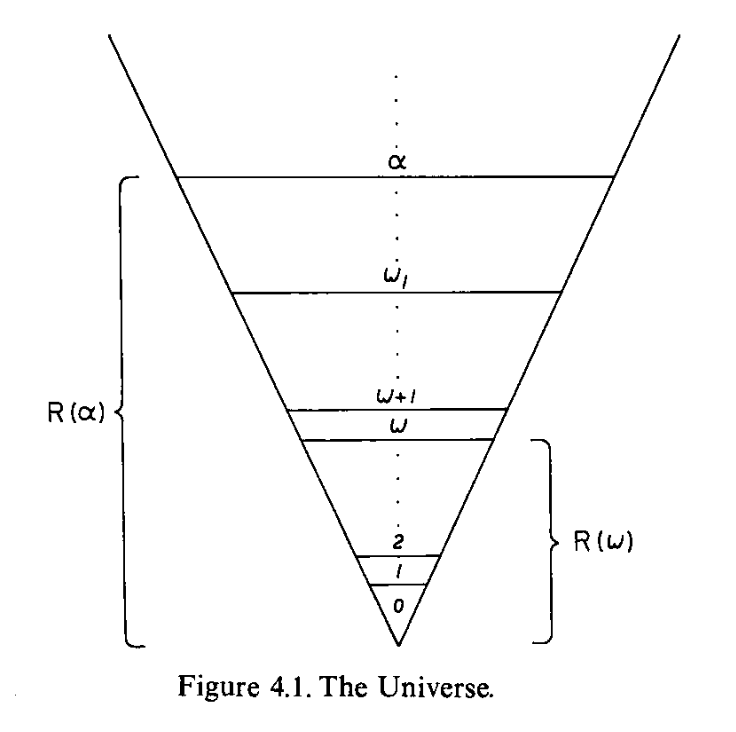Can someone explain this by chance?
196
Be sure to follow the rule before you head out.
Rule: You must post before you leave.
in this context, the "universe" means "the collection of all sets", or more specifically, the Von Neumann universe (which is just a method of iteratively constructing "all" the sets). and so the figure is providing a way to visualize the collection of all sets.
this is done by assigning a so-called "rank" to each set. the notion of "rank" is kind of annoying to define in simple terms, but it's basically used as a tool for proving things by induction. it does this by assigning an ordinal number to each set. (ordinal numbers are "basically" a "continuation" of the positive whole numbers, in the sense that for any ordinal number ɑ, you can define the successor ordinal ɑ + 1; so, it's kind of like a way of formalizing the concept of ∞ + 1.)
you can think of "rank" as analogous to "cardinality", in the following way. the "cardinality" of a set is a cardinal number that basically says "how big" the set is. meanwhile, the "rank" of a set is an ordinal number that roughly says """how big""" that set is. (notice that there are a few extra scare quotes this time.)
lastly, the the set R(ɑ), where ɑ is an ordinal, is the set of all sets that have rank less than ɑ. i.e., the R(ɑ) is the set of all sets that have """size""" smaller than ɑ.
and this kind of explains the visualization using a cone: there are more sets of "size" < 4 than there are of sets "size" < 3, and there are more sets of "size" < 3 than there are sets of "size" < 2. so it kind of lets you see "the universe" as a cone in that way.
~~You know the counting numbers? 1, 2, 3, so on?
There's infinitely many.
But there's fewer of them than the "reals", which are numbers like 1.5, 42.7, and pi (basically all the whole numbers and all the ones in between).
This diagram is showing the "Continuum Hypothesis" which says that there might be some set of numbers that are "in between" the counting numbers and the reals in terms of size. We (humanity) do not yet know for certain if it's true or not.
This is obviously a gross oversimplification that probably gets some important details wrong.~~
This has nothing to do with CH. In the middle cone there are counting numbers (ordinals to be precise), with the numbers omega (the smallest counting number which is bigger than any natural number, like an infinity-th counting number), omega+1 (the counting number after omega, a bit like infinity+1) and omega_1 (the first counting number which has no 1-1 correspondence with omega) marked explicitly. The alpha may be replaced by any infinite counting number.
The R(alpha) at the side are just some examples, how far "the universe" (something properly defined in the book) has to go up to to do reasonable set theory. Those R(alpha) are just the sets (think of them like nice enough collections of objects) which can be constructed in a finite amount of steps from the set containing nothing.
Also, as for the second to last paragraph in your comment, it is known that CH is independent of ZFC, the axioms most commonly used for set theory.
Thank you for the far more detailed (and correct!) explanation.
The years start coming and they don't stop coming
This is an excellent visualization, I might have to check this book out.
